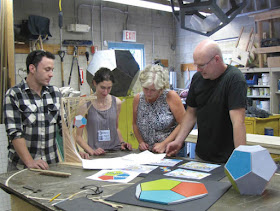Creating new exhibits is the work of the X team. While it sounds like a group of crime-fighting superheroes, X team is short for exhibits team and includes Exhibits Director Robin Meisner, Exhibit Designer & Fabricator Chris Sancomb, Exhibit Technician Hillel O’Leary, Graphic Designer Valerie Haggerty-Silva and Executive Director Janice O’Donnell as primary players (also known as miniX). The full team also includes the Museum’s entire education staff, including visitor services, and communications director. The X team has a collective 194 years of experience in informal learning, with miniX adding up to 101 years of exhibit design! The miniX designers are RISD-trained artists – Chris in Sculpture and Val and Hillel in Illustration – and Robin has a doctorate in Education Research, focusing on informal learning in museum exhibits.
 |
| A meeting of miniX – Hillel, Robin, Val and Chris. |
Seed – The Big Idea
Once we know a topic, we start by thinking about our exhibit learning goals, target age and main messages – what we hope both children and parents will take away. We also think about what we call avenues of exploration – how we want kids and their caregivers to explore these concepts.
Bud – Concept and Design Development
Then we translate the concepts and goals into actual components by thinking about what kids are going to do, which is a challenging but fun process. We identify the range of activities – like fine and gross motor – and try to balance what we think makes for a strong exhibit overall. We begin to think about what the exhibit is going to look and feel like – its aesthetic and preliminary layout and design. The bud phase also includes budget estimates and a timeline for creating the exhibit.
 |
| MiniX having a pre-bud discussion about the layout of ThinkSpace, a major new exhibit about spatial thinking that opens in November. |
We refine and finalize how we’ll create the exhibit, including components, budget and production schedule. All of the activities are fully detailed, including construction drawings, and design is finalized. All exhibit items are costed out and venders and subcontractors identified. Basically, we confirm what we’re going to do and make sure we can do it all within budget and when we say we’re going to!
 |
| A presentation about final ThinkSpace plans to the entire X team, to get buy-in and achieve blossom. |
We build the exhibit! This phase takes many months and includes the fabrication and installation of all components and graphics as well as renovations to the surrounding environment, like repainting and recarpeting. It also includes creating assessment and communications plans and staff training.
Preserves – Assessment, Fine Tuning and Maintenance
After the exhibit is open, we spend a lot of time observing to see how visitors use the components and assess whether they work as intended. We plan for ongoing operations and maintenance and, over time, make changes to anything not working and reassess.
The full process generally takes a year or two, and the cycle begins all over again with the next new exhibit.
Stay tuned for more details about the process of planning, prototyping and fabricating ThinkSpace, and learn more about the new environment in the Museum's fall newsletter.
 |
| Prototypes of ThinkSpace components. This is the first exhibit where the X team has built and tested prototypes of nearly all of the components. |






















